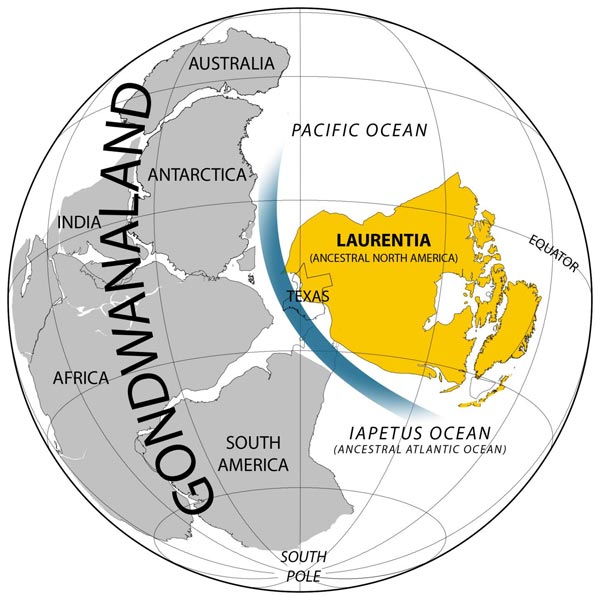Massive geographic change may have triggered explosion of animal life

A new analysis from The University of Texas at Austin's Institute for Geophysics suggests a deep oceanic gateway, shown in blue, developed between the Pacific and Iapetus oceans immediately before the Cambrian sea level rise and explosion of life in the fossil record, isolating Laurentia from the supercontinent Gondwanaland. Credit: Ian Dalziel
A new analysis of geologic history may help solve the riddle of the “Cambrian explosion,” the rapid diversification of animal life in the fossil record 530 million years ago that has puzzled scientists since the time of Charles Darwin.
A paper by Ian Dalziel of The University of Texas at Austin's Jackson School of Geosciences, published in the November issue of Geology, a journal of the Geological Society of America, suggests a major tectonic event may have triggered the rise in sea level and other environmental changes that accompanied the apparent burst of life.
The Cambrian explosion is one of the most significant events in Earth's 4.5-billion-year history. The surge of evolution led to the sudden appearance of almost all modern animal groups. Fossils from the Cambrian explosion document the rapid evolution of life on Earth, but its cause has been a mystery.
The sudden burst of new life is also called “Darwin's dilemma” because it appears to contradict Charles Darwin's hypothesis of gradual evolution by natural selection.
“At the boundary between the Precambrian and Cambrian periods, something big happened tectonically that triggered the spreading of shallow ocean water across the continents, which is clearly tied in time and space to the sudden explosion of multicellular, hard-shelled life on the planet,” said Dalziel, a research professor at the Institute for Geophysics and a professor in the Department of Geological Sciences.
Beyond the sea level rise itself, the ancient geologic and geographic changes probably led to a buildup of oxygen in the atmosphere and a change in ocean chemistry, allowing more complex life-forms to evolve, he said.
The paper is the first to integrate geological evidence from five present-day continents — North America, South America, Africa, Australia and Antarctica — in addressing paleogeography at that critical time.
Dalziel proposes that present-day North America was still attached to the southern continents until sometime into the Cambrian period. Current reconstructions of the globe's geography during the early Cambrian show the ancient continent of Laurentia — the ancestral core of North America — as already having separated from the supercontinent Gondwanaland.
In contrast, Dalziel suggests the development of a deep oceanic gateway between the Pacific and Iapetus (ancestral Atlantic) oceans isolated Laurentia in the early Cambrian, a geographic makeover that immediately preceded the global sea level rise and apparent explosion of life.
“The reason people didn't make this connection before was because they hadn't looked at all the rock records on the different present-day continents,” he said.
The rock record in Antarctica, for example, comes from the very remote Ellsworth Mountains.
“People have wondered for a long time what rifted off there, and I think it was probably North America, opening up this deep seaway,” Dalziel said. “It appears ancient North America was initially attached to Antarctica and part of South America, not to Europe and Africa, as has been widely believed.”
Although the new analysis adds to evidence suggesting a massive tectonic shift caused the seas to rise more than half a billion years ago, Dalziel said more research is needed to determine whether this new chain of paleogeographic events can truly explain the sudden rise of multicellular life in the fossil record.
“I'm not claiming this is the ultimate explanation of the Cambrian explosion,” Dalziel said. “But it may help to explain what was happening at that time.”
To read the paper go to http://geology.gsapubs.org/content/early/2014/09/25/G35886.1.abstract
Media Contact
All latest news from the category: Earth Sciences
Earth Sciences (also referred to as Geosciences), which deals with basic issues surrounding our planet, plays a vital role in the area of energy and raw materials supply.
Earth Sciences comprises subjects such as geology, geography, geological informatics, paleontology, mineralogy, petrography, crystallography, geophysics, geodesy, glaciology, cartography, photogrammetry, meteorology and seismology, early-warning systems, earthquake research and polar research.
Newest articles

NASA: Mystery of life’s handedness deepens
The mystery of why life uses molecules with specific orientations has deepened with a NASA-funded discovery that RNA — a key molecule thought to have potentially held the instructions for…

What are the effects of historic lithium mining on water quality?
Study reveals low levels of common contaminants but high levels of other elements in waters associated with an abandoned lithium mine. Lithium ore and mining waste from a historic lithium…

Quantum-inspired design boosts efficiency of heat-to-electricity conversion
Rice engineers take unconventional route to improving thermophotovoltaic systems. Researchers at Rice University have found a new way to improve a key element of thermophotovoltaic (TPV) systems, which convert heat…



